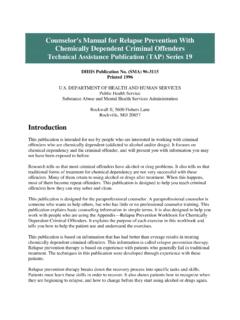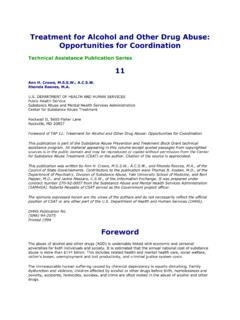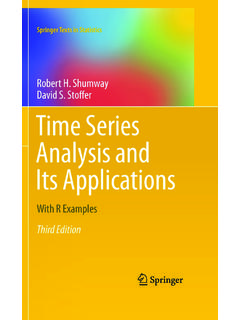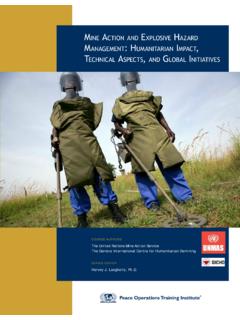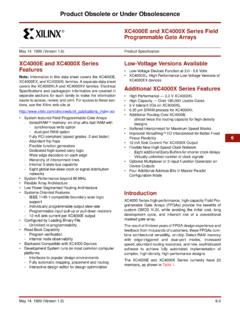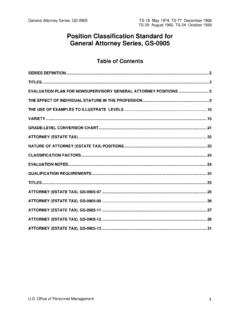Transcription of TIP 40: Clinical Guidelines for the Use of Buprenorphine ...
1 TIP 40: Clinical Guidelines for the Use of Buprenorphine in the treatment of opioid addiction : treatment improvement protocol (TIP) series 40. Laura McNicholas, , , Consensus Panel Chair A72248. DEPARTMENT OF HEALTH AND HUMAN SERVICES. Substance Abuse and Mental Health Services Administration Center for Substance Abuse treatment 1 Choke Cherry Road Rockville, MD 20857. This treatment improvement protocol (TIP), Clinical Guidelines for the Use of Buprenorphine in the treatment of opioid addiction , provides consensus and evidence based treatment guidance for the use of Buprenorphine , a new option for the treatment of opioid addiction .
2 The goal of this TIP is to provide physicians with information they can use to make practical and informed decisions about the use of Buprenorphine to treat opioid addiction . These Guidelines address the pharmacology and physiology of opioids, opioid addiction , and treatment with Buprenorphine ;. describe patient assessment and the choice of opioid addiction treatment options; provide detailed treatment protocols for opioid withdrawal and maintenance therapy with Buprenorphine ;. and include information on the treatment of special populations, , pregnant women, adolescents, and polysubstance users.
3 This TIP represents another step by the Center for Substance Abuse treatment (CSAT) toward its goal of bringing national leaders together to improve substance use disorder treatment in the United States. DHHS Publication No. (SMA) 04 3939. Printed 2004. Acknowledgments Numerous people contributed to the development of this TIP (see pp. ix, xi, and appendix J). This publication was produced by the American Institutes for Research (AIR) under the Center for Substance Abuse treatment (CSAT) contract, task order number 277 00 6401 under the Substance Abuse and Mental Health Services Administration (SAMHSA) contract, Number 277 99 6400, Department of Health and Human Services (DHHS).
4 CAPT Susanne Caviness, , SR SURG Angel A. Gonz lez, , and Raymond Hylton, Jr., , , served as the CSAT Government Project Officers. Anton C. Bizzell, , and Alan Trachtenberg, , , served as the CSAT Medical Editors. Christina Currier served as the CSAT TIPs Task Leader. Elizabeth F. Howell, , served as the Senior Medical Editor. Wayne Brandes, , , served as the AIR Medical Editor and Project Director. Janet Carrese served as the AIR Deputy Project Director. Other AIR personnel included Susan Bratten, Senior Editor; Susan Keller, , , , Quality Assurance Editor; and Patricia Louthian, Document Production Specialist.
5 In addition, Center for Health Policy Studies (CHPS) Consulting staff Roy Walker, , Kimberly Stern, , Elly Gilbert, , , , and Ji Kim served as the original support team for the consensus and field review panels. Writers were Margaret Boone, ; Nancy J. Brown; Mary A. Moon; Deborah J. Schuman; Josephine Thomas, ; and Denise L. Wright, Disclaimer The opinions expressed herein are the views of the consensus panel members and do not necessarily reflect the official position of CSAT, SAMHSA, or DHHS. No official support of or endorsement by CSAT, SAMHSA or DHHS for these opinions or for particular instruments, software, or resources described in this document are intended or should be inferred.
6 The Guidelines in this document should not be considered substitutes for individualized client care and treatment decisions. Public Domain Notice All materials appearing in this volume except those taken directly from copyrighted sources are in the public domain and may be reproduced or copied without permission from SAMHSA/CSAT. or the authors. Do not reproduce or distribute this publication for a fee without specific, written authorization from SAMHSA's Office of Communications. Electronic Access and Copies of Publication Copies may be obtained free of charge from SAMHSA's National Clearinghouse for Alcohol and Drug Information (NCADI), (800) 729 6686 or (301) 468 2600; TDD (for the hearing impaired), (800) 487 4889; or electronically through the following site: Recommended Citation Center for Substance Abuse treatment .
7 Clinical Guidelines for the Use of Buprenorphine in the treatment of opioid addiction . treatment improvement protocol (TIP) series 40. DHHS. Publication No. (SMA) 04 3939. Rockville, MD: Substance Abuse and Mental Health Services Administration, 2004. Originating Office Division of Pharmacologic Therapies, Center for Substance Abuse treatment , Substance Abuse and Mental Health Services Administration, 1 Choke Cherry Road, Rockville, MD 20857. DHHS Publication No. (SMA) 04 3939. Printed 2004. What Is a TIP? treatment improvement Protocols (TIPs) are best practice Guidelines for the treatment of substance use disorders, provided as a service of the Substance Abuse and Mental Health Services Administration's (SAMHSA's) Center for Substance Abuse treatment (CSAT).
8 CSAT's Office of Evaluation, Scientific Analysis and Synthesis draws on the experience and knowledge of Clinical , research, and administrative experts to produce the TIPs, which are distributed to a growing number of facilities and individuals across the country. As alcoholism and other substance use disorders are increasingly recognized as major problems, the audience for the TIPs is expanding beyond public and private substance use disorder treatment facilities. After selecting a topic, CSAT invites staff from pertinent Federal agencies and national organizations to a resource panel that recommends specific areas of focus as well as resources that should be considered in developing the content of the TIP.
9 Then recommendations are communicated to a consensus panel composed of experts who have been nominated by their peers. This panel participates in a series of discussions; the information and recommendations on which they reach consensus become the foundation of the TIP. The members of each consensus panel represent substance use disorder treatment programs, hospitals, community health centers, counseling programs, criminal justice and child welfare agencies, and private practitioners. A panel chair (or cochairs) ensures that the Guidelines mirror the results of the group's collaboration.
10 A large and diverse group of experts reviews the draft document closely. The Buprenorphine Expert Panel, a distinguished group of substance abuse experts and professionals in such related fields as primary care, mental health, and social services, worked with the Consensus Panel Chair and the CSAT Division of Pharmacologic Therapies to generate new and updated changes to the subject matter for this TIP based on the field's current needs for information and guidance. Once the changes recommended by the field reviewers have been incorporated, the TIP is prepared for publication in print and online.
